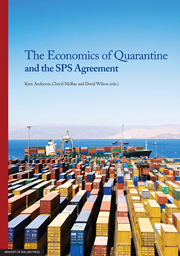Book contents
- Frontmatter
- Contents
- List of tables, figures and boxes
- Acronyms
- Preface
- List of contributors
- 1 Introduction
- PART I The multilateral rules under WTO
- PART II The ‘appropriate level of protection’
- 6 Appropriate level of protection: a European perspective
- 7 Appropriate level of protection: an Australian perspective
- 8 Appropriate level of protection: a New Zealand perspective
- 9 Beyond iso-risk to include benefits under the SPS Agreement
- 10 Integrating import risk and trade benefit analysis
- PART III Adding more economics to risk analysis
- PART IV Specific health and environmental risks from trade
- PART V Conclusion
- APPENDIX The legal text of the SPS Agreement
6 - Appropriate level of protection: a European perspective
from PART II - The ‘appropriate level of protection’
Published online by Cambridge University Press: 05 June 2013
- Frontmatter
- Contents
- List of tables, figures and boxes
- Acronyms
- Preface
- List of contributors
- 1 Introduction
- PART I The multilateral rules under WTO
- PART II The ‘appropriate level of protection’
- 6 Appropriate level of protection: a European perspective
- 7 Appropriate level of protection: an Australian perspective
- 8 Appropriate level of protection: a New Zealand perspective
- 9 Beyond iso-risk to include benefits under the SPS Agreement
- 10 Integrating import risk and trade benefit analysis
- PART III Adding more economics to risk analysis
- PART IV Specific health and environmental risks from trade
- PART V Conclusion
- APPENDIX The legal text of the SPS Agreement
Summary
As traditional barriers to agricultural trade have diminished, there has been increased attention focused on the impact of sanitary and phytosanitary (SPS) measures on trade. The implementation of the SPS Agreement has defined a series of rights and principles for the regulation of SPS measures that have the potential to impede trade. Furthermore, the enhanced transparency of SPS measures provided for under the Agreement, and the desire to avoid the great economic costs associated with the WTO's dispute settlement procedures, are engendering greater discipline in the application of SPS measures amongst Members. Simultaneously, however, the increased application of SPS measures and growing use of new technologies, for example biotechnology, are likely to generate increased tensions and disputes between trading partners regarding the legitimacy of these measures.
The SPS Agreement confirms the right of Members to implement SPS measures provided they satisfy the requirements of the Treaty, in particular a commitment to apply measures that are least trade distortive. Furthermore, the Agreement permits Members to define their own ‘appropriate level of protection’ (ALOP), that level of protection deemed to be acceptable and which the SPS measures applied aim to achieve. This chapter explores the concept of ALOP as applied in the European Union (EU). It describes the concept of ALOP as defined by the SPS Agreement, explores how this concept is applied by the EU and evaluates the extent to which this accords with the Agreement. Two key issues associated with the EU’s ALOP are explored, namely the ‘precautionary principle’ and the role of ‘other legitimate factors’ in establishing SPS measures.
- Type
- Chapter
- Information
- The Economics of Quarantine and the SPS Agreement , pp. 105 - 131Publisher: The University of Adelaide PressPrint publication year: 2012

